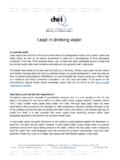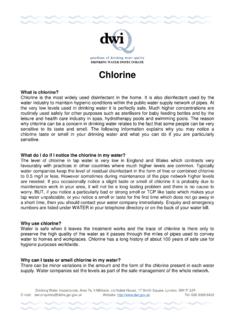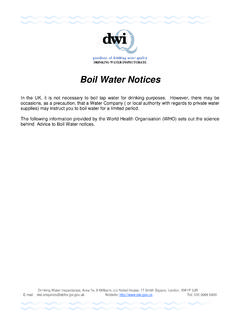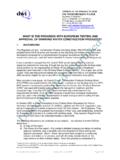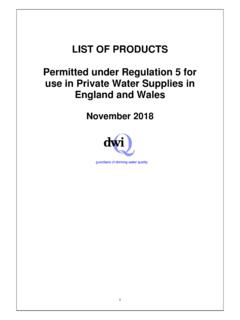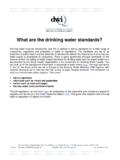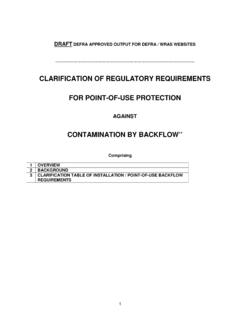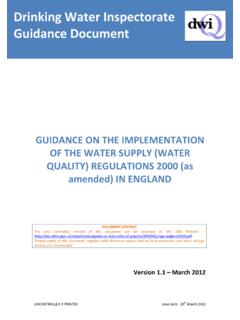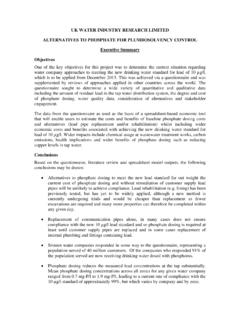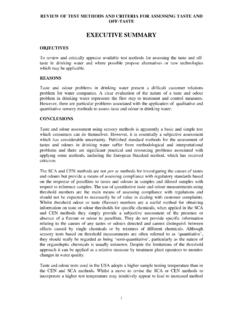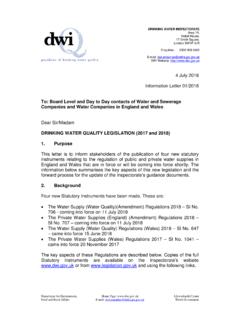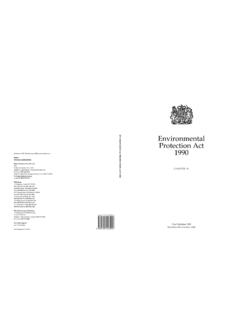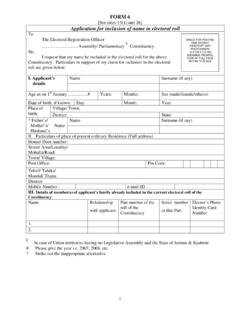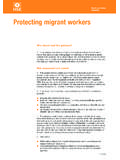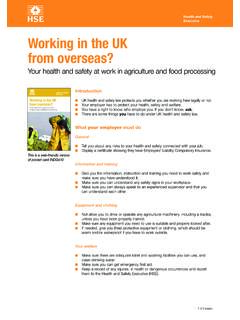Transcription of DRINKING WATER INSPECTORATE - DWI, UK
1 DRINKING WATER INSPECTORATE , Area 7e, 9 Millbank, c/o Nobel House, 17 Smith Square, London, SW1P 3JR E-mail: Website: Tel: 030 0068 6400 DRINKING WATER INSPECTORATE WATER storage tanks and cisterns Is stored WATER safe to drink? Many older properties have cold WATER storage tanks in the roof space or loft. In most cases this storage tank will provide cold WATER to upstairs bathrooms but in some properties all of the cold WATER taps may be fed from this tank. The condition of this tank may have an impact on WATER quality. Ideally you should only use a tap connected to the mains WATER supply for DRINKING , food preparation or teeth cleaning; however if your DRINKING WATER comes from a storage tank then it will be safe to use if the tank is properly designed, correctly installed and kept in good condition.
2 Do I have a WATER storage tank? In older houses the kitchen cold tap maybe the only tap connected directly to the mains. However, in newer homes, especially those with unvented heating systems, all the hot and cold taps are likely to be supplied directly under mains pressure. If you are not sure whether a tap is connected to the mains supply a quick check is to place your thumb over the tap outlet. If you are able to hold back all the WATER with your thumb when the tap is fully open then the tap is likely to be connected to a tank not the mains. If in doubt ask a qualified plumber to check out the plumbing arrangements for you. Is my tank in good condition? If you rely on a tank for your DRINKING WATER it should meet the following requirements: not too large, so the WATER in the tank is frequently replenished with fresh WATER (250 litres is quite sufficient for most homes) made of approved materials; traditionally tanks were made of galvanised iron and these rust over time leading to bits in the WATER or a brown or yellowish tinge or a metallic taste.
3 Nowadays tanks are constructed of plastic (polyethylene) and unlikely to cause problems provided that are designed for DRINKING WATER purposes and have a close fitting cover. Look for the WRAS Approved Product logo which ensures the tank material is of an approved type. Click here for more details. has a lid which excludes light and is tightly fitting and securely fastened, so that birds, vermin, and dust cannot get in to the WATER ; has vents, including overflow, that are screened so that insects and particles cannot get in; insulated and not exposed to sunlight and not located near to any source of heat so the stored WATER is kept as cold as practicable; DRINKING WATER INSPECTORATE , Area 7e, 9 Millbank, c/o Nobel House, 17 Smith Square, London, SW1P 3JR E-mail: Website: Tel: 030 0068 6400 periodic visual checks to make sure there has not been a build up of scale or deposits on the tank floor and the lid and screens are securely in place in public buildings, workplaces, health care premises and social housing all WATER tanks will be checked and cleaned as part of the arrangements that must be in place for legionella control purposes.
4 If you are renting your property privately then your landlord is responsible for these checks. Be aware that WATER in a tank will deteriorate, if: there is no lid on the storage tank; the WATER becomes warm; too much WATER is stored and turnover is low; the tank is made from or lined with an unsuitable material; work on the tank is carried out by an unqualified person. If I suspect a problem, who is responsible for putting it right? The building owner is responsible for all aspects of the plumbing system and its maintenance, which includes the underground supply pipe from the boundary of the highway to the inside stopcock. New plumbing systems, and alterations and additions to older systems, must comply with regulations known as the WATER Fittings Regulations, 1999. Your local WATER company enforces these regulations will carry out an inspection on request and advise you of any deficiencies that need to be rectified.
5 If you are a tenant then your landlord or managing agent should be able to tell you if the DRINKING WATER is from storage, what inspection and maintenance has been carried out on the DRINKING WATER cistern, and what WATER quality samples have been taken. A landlord, or managing agent, should also be able to supply records of inspections and sampling results. The requirements for landlords are set out in BSEN 806-5 Specification for installations inside buildings conveying WATER for human consumption operation and maintenance and BS 8558, the associated guidance document. What if I suspect the WATER is unsafe? Contact either your local WATER company or the environmental health team at your local council and explain your concerns to them. Depending on the exact situation, either the council or the WATER company will investigate and require the person responsible for the building WATER supply to make improvements.
6 If you are the person who is responsible you will be given advice about what you need to do to rectify the problem. What if I make changes to my tank or cistern? If you decide to make changes to your WATER storage tank or cistern then you will need to make sure the changes you make do not affect the WATER quality, especially if this is supplying your DRINKING WATER . You will need to make sure a replacement tank is of an approved type and installed correctly by an approved plumber. Certain changes to internal plumbing systems require prior notification to the local WATER company. DRINKING WATER INSPECTORATE , Area 7e, 9 Millbank, c/o Nobel House, 17 Smith Square, London, SW1P 3JR E-mail: Website: Tel: 030 0068 6400 Specific requirements for landlords BSEN 806-5 Specification for installations inside buildings conveying WATER for human consumption operation and maintenance.
7 This standard provides specific requirements for the operation and maintenance of installations inside buildings. Section 6 of this document provides details on operation, section 12 provides details on maintenance, annex A provides details on frequency for inspection and maintenance and annex B provides details on inspection and maintenance procedures. BS 8558 Guide to the design, installation, testing and maintenance of services supplying WATER for domestic use within buildings and their curtilages guidance on BSEN 806. This standard provides additional guidance on best practice and section 6 provides details on WATER quality checks for stored WATER . Last updated: July 2013
